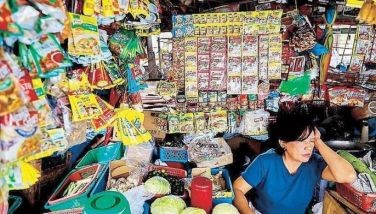CARP: Redistributing poverty!

During the last Cabinet meeting, I understand that P-Noy was perplexed by the issue of persistent poverty. In his way of thinking, he might have thought that by making the CCT a flagship program of his administration and pouring billions into it, even a tiny bit of improvement would manifest by now.
By the end of the long meeting, I am told that P-Noy gave orders to his Cabinet members to intensify anti-poverty measures in the rural areas. At least, he knows this is where we can find most of our poor people.
If P-Noy was bolder and not conflicted by family ties, he could have also taken a stand to stop this charade we call our land reform program. The present law is due to expire this June and even now, there are those who are advocating extending the law and throwing even more money into it.
Before we do any such thing, it is time to honestly evaluate how the program has performed over the last 25 years. The best place to start the review is a discussion paper on the subject written by Dr. Raul V. Fabella of the UP School of Economics. Dr. Fabella is also a National Scientist.
Dr. Fabella’s paper is extensive and space limitations prevent me from reproducing it here. But I will try to pick some of Dr. Fabella’s more important findings and observations that ought to be considered in how we should proceed on land reform if the objective is to reduce poverty.
Dr. Fabella starts with a review of CARP over the quarter century of its existence. He points out that “by 2014, 5.05 million of the 5.37m hectares of the targeted agricultural land shall have been distributed.
“As a program for land asset equity, it shall have accomplished 99 percent of its target, whopper of a success for a government program. As a program to advance the economic welfare of farmers, it has accomplished the opposite of its stated goals.â€
Dr. Fabella found productivity has fallen drastically in coconut and sugar and poverty incidence among agrarian reform beneficiaries in agrarian reform communities stood at 54% in 2011 higher than for farmers in general. “CARP and CARPER has created a new class of people: the landed poor.â€
Many of us often talk of successful land reform programs in Japan and Taiwan. Dr. Fabella sets the record straight on what actually happened in those countries.
“Japan’s vaunted land reform distributed only 1.76 million hectares of its total 37 million or 4.7 percent. Taiwan distributed 0.5 million hectares of its total of 3.63 million or 14 percent. Note that the Japanese land reform was carried out by the Allied Occupation Forces, while Taiwan’s was by the virtual military government of the Kuomintang Party under Generalissimo Chiang Kai Shek.â€
Where did we go wrong? Land reform to succeed, Dr. Fabella observed, requires some very stringent governance and design requirements which copycats conveniently forgot.
“First, those early post-war land reform episodes were over and done in no more than five years. They succeeded because they knew when and where to stop.
“Japan’s, Taiwan’s and South Korea’s land reform largely stopped at rice lands! By contrast CARP has lasted 25 years and took on all crops. Counting the years from the original rice and corn land reform in 1964, we already had half a century of land reform.â€
Our problem, Dr. Fabella pointed out, is that “as in most weak states, form and ambition were pushed to substitute for substance and, as with all government boondoggles, failure was trafficked as a sure sign of lack of funds.â€
What is worse for CARP, according to the National Scientist, is its outcome on beneficiaries’ quality of life. Quality of life is correlated with being above or below the poverty line.
The UP economist points out a survey showing that among agrarian reform communities, 54 percent of households fell below the poverty line! The 2009 FIES (or the Family Income and Expenditure Survey) data show that only 35 percent of farmers fell below the poverty line. This seems to say, he said, that agrarian reform farmer beneficiaries of CARP had become poorer!
A big problem is the expectation for beneficiaries to become owner-cultivators in order to retain the land. But running a farm is a complex entrepreneurial and managerial undertaking.
Dr. Fabella points out that “the farmer-owner has to arrange financing, do the land preparation, procure the seeds and fertilizer, do the weeding, decide on the timing of planting, seeding and harvest, contract a buyer and negotiate the price with the buyer and hope to God the weather cooperates... Few people are equipped to deal successfully with this plethora of decisions.
“If the beneficiary does not have the requisite entrepreneurship and managerial aptitude, he/she will surely drown in debt and may fare better as a wage employee. But with CARP, he/she cannot legally opt out if he/she wants to hold on to the land; he/she is forced to be an entrepreneur.â€
A key problem of our land reform program has to do with property rights. “Unsettled property rights have always in history been a predictor of economic stagnation and the Philippine farm sector is just another instance of this.â€
Dr. Fabella recalls that “CARP has dragged on for over two decades now; this means that the Philippine agricultural economy has suffered two decades of ill defined and contested property rights leading to highly uncertain investment climate in agriculture.â€
Dr. Fabella also does not subscribe to the common notion, specially of some Catholic bishops, that CARP’s meager harvest is due to inadequate provision of extension services required to make the farmers economically viable. “Their common prescription is therefore to throw more money at the failure. Some will now advocate CARPERER. We do not share this view.â€
Dr. Fabella believes the program failed because of bad design and no amount of money can save it. More money is just a prescription for permanent failure.
Additionally, Dr Fabella also notes a moral hazard for bureaucrats and politicians advocating more money thrown into the program. “Why, indeed succeed when failure brings the money. Second, there is better use for the money. Would not the P160 billion already spent by 2009 have been better spent to subsidize the education of the children of target landless tenant households?â€
Third, Dr. Fabella warns that “flawed design will make a program a resource black hole. CARP was -- and CARPER is -- fundamentally flawed in its design: it seeks to empower the beneficiary with land ownership and then undermines this ownership by (a) forcing a three hectare limit on awarded farm sizes for all crops, thus negating possible scale economies (rife in sugar, for example); and (b) outlawing the tradability of land and/or its use which would facilitate more optimal use and assignment.
“The demise of the formal land market effectively disemboweled the formal rural credit market, making credit accessible only from the underground or trader mediated credit markets. The exorbitant interest rates in the latter (up to 70 percent) mean that the farmer is no better than a share tenancy contract (50 to 70 percent).â€
“CARP has effectively chased away private capital from agriculture with the five-hectare ownership limit,†Dr. Fabella observes. “While private capital is not interested in owning the land, they cannot be expected to deal with a thousand farmers to rent two thousand hectares to cultivate.
“Where private capital dared test the waters, it ended up in a circus: e.g., the San Miguel Food Corp. swine project at Sumilao. CARP has effectively sent the agricultural credit market underground. It has presumed that farmers automatically morph into entrepreneur-businessmen with access to land.â€
One other failure of CARP is it has “disallowed the selling or renting of land in the open market until paid up, and paid up is elusive under the CARP restrictions. With 1.2 hectares average landholding and half a hectare under cultivation, on average, beneficiaries cannot be expected to breach the poverty ceiling…â€
Dr. Fabella thinks it is “now is the time to let go. We now have to redirect our agricultural focus from land equity to farm efficiency. More productive farmers should now be allowed to legally own and cultivate 10 or more hectares as market efficiency dictates. Corporations registered with the Philippine Stock Exchange and owned by thousands should have no agricultural land ownership ceiling.
“Private capital must be attracted back into agriculture. Banks operating in the rural areas and lending to farmers should be allowed considerable latitude in ownership of agricultural land…â€
“To echo the architect of the great Chinese Economic Miracle, Deng Xiaoping: It is time to stop redistributing poverty!â€
Boo Chanco’s e-mail address is [email protected]. Follow him on Twitter @boochanco
- Latest
- Trending





























